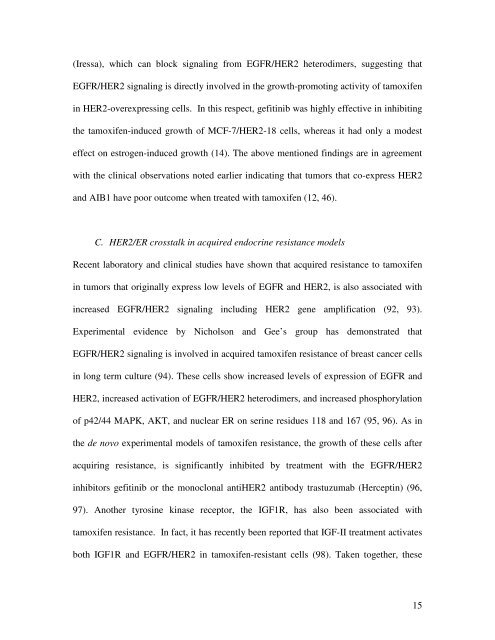Create successful ePaper yourself
Turn your PDF publications into a flip-book with our unique Google optimized e-Paper software.
(Iressa), which can block signaling from EGFR/H<strong>ER</strong>2 heterodimers, suggesting that<br />
EGFR/H<strong>ER</strong>2 signaling is directly involved in the growth-promoting activity of tamoxifen<br />
in H<strong>ER</strong>2-overexpressing cells. In this respect, gefitinib was highly effective in inhibiting<br />
the tamoxifen-induced growth of MCF-7/H<strong>ER</strong>2-18 cells, whereas it had only a modest<br />
effect on estrogen-induced growth (14). The above mentioned findings are in agreement<br />
with the clinical observations noted earlier indicating that tumors that co-express H<strong>ER</strong>2<br />
and AIB1 have poor outcome when treated with tamoxifen (12, 46).<br />
C. H<strong>ER</strong>2/<strong>ER</strong> crosstalk in acquired endocrine resistance models<br />
Recent laboratory and clinical studies have shown that acquired resistance to tamoxifen<br />
in tumors that originally express low levels of EGFR and H<strong>ER</strong>2, is also associated with<br />
increased EGFR/H<strong>ER</strong>2 signaling including H<strong>ER</strong>2 gene amplification (92, 93).<br />
Experimental evidence by Nicholson and Gee’s group has demonstrated that<br />
EGFR/H<strong>ER</strong>2 signaling is involved in acquired tamoxifen resistance of breast cancer cells<br />
in long term culture (94). These cells show increased levels of expression of EGFR and<br />
H<strong>ER</strong>2, increased activation of EGFR/H<strong>ER</strong>2 heterodimers, and increased phosphorylation<br />
of p42/44 MAPK, AKT, and nuclear <strong>ER</strong> on serine residues 118 and 167 (95, 96). As in<br />
the de novo experimental models of tamoxifen resistance, the growth of these cells after<br />
acquiring resistance, is significantly inhibited by treatment with the EGFR/H<strong>ER</strong>2<br />
inhibitors gefitinib or the monoclonal antiH<strong>ER</strong>2 antibody trastuzumab (Herceptin) (96,<br />
97). Another tyrosine kinase receptor, the IGF1R, has also been associated with<br />
tamoxifen resistance. In fact, it has recently been reported that IGF-II treatment activates<br />
both IGF1R and EGFR/H<strong>ER</strong>2 in tamoxifen-resistant cells (98). Taken together, these<br />
15











